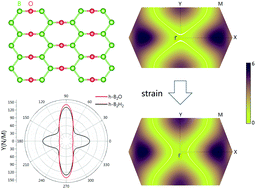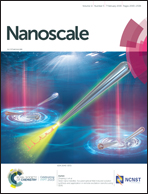Two-dimensional honeycomb borophene oxide: strong anisotropy and nodal loop transformation†
Abstract
The search for topological semimetals is mainly focused on heavy-element compounds by following the footsteps of previous research on topological insulators, with less attention on light-element materials. However, the negligible spin orbit coupling with light elements may turn out to be beneficial for realizing topological band features. Here, using first-principles calculations, we propose a new two-dimensional light-element material—the honeycomb borophene oxide (h-B2O), which has nontrivial topological properties. The proposed structure is based on the recently synthesized honeycomb borophene on an Al (111) substrate [W. Li, L. Kong, C. Chen, J. Gou, S. Sheng, W. Zhang, H. Li, L. Chen, P. Cheng and K. Wu, Sci. Bull., 2018, 63, 282–286]. The h-B2O monolayer is completely flat, unlike the oxides of graphene or silicene. We systematically investigate the structural properties of h-B2O, and find that it has very good stability and exhibits significant mechanical anisotropy. Interestingly, the electronic band structure of h-B2O hosts a nodal loop centered around the Y point in the Brillouin zone, protected by the mirror symmetry. Furthermore, under moderate lattice strain, the single nodal loop can be transformed into two loops, each penetrating through the Brillouin zone. The loops before and after the transition are characterized by different ![[Doublestruck Z]](https://www.rsc.org/images/entities/char_e17d.gif) ×
× ![[Doublestruck Z]](https://www.rsc.org/images/entities/char_e17d.gif) topological indices. Our work not only predicts a new two-dimensional material with interesting physical properties, but also offers an alternative approach to search for new topological phases in 2D light-element systems.
topological indices. Our work not only predicts a new two-dimensional material with interesting physical properties, but also offers an alternative approach to search for new topological phases in 2D light-element systems.



 Please wait while we load your content...
Please wait while we load your content...